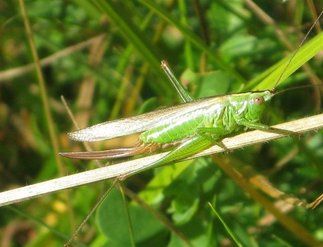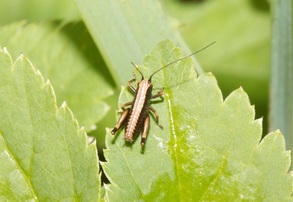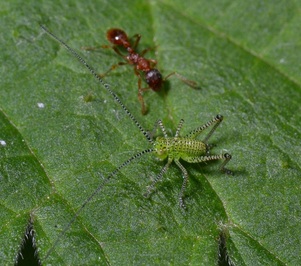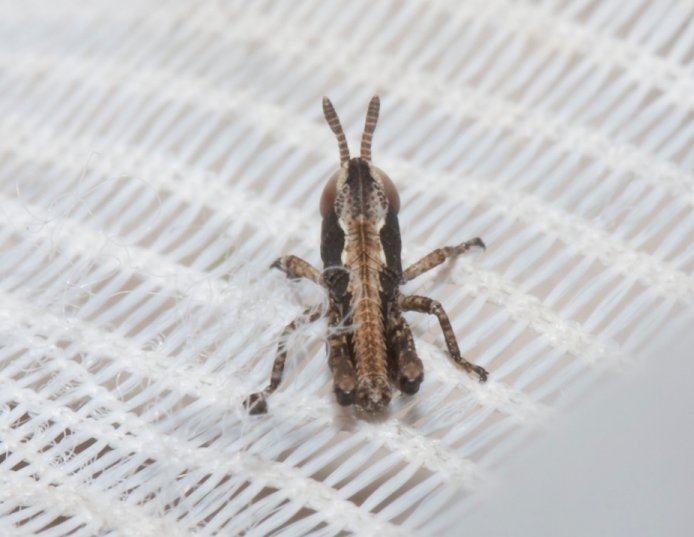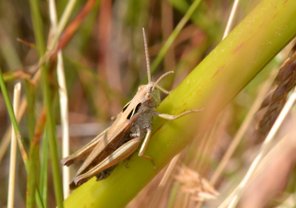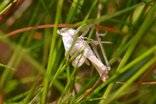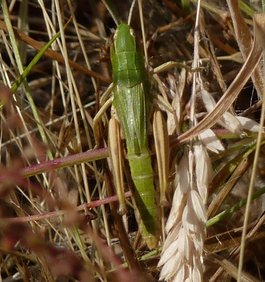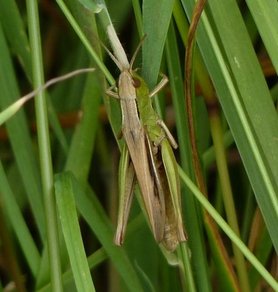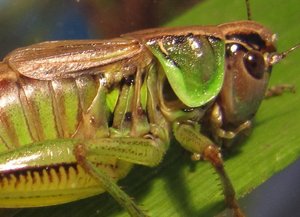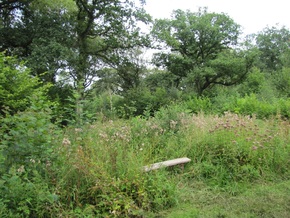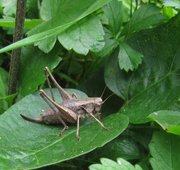Back to 2013
Warm weather results in extra long-winged Long-winged Coneheads
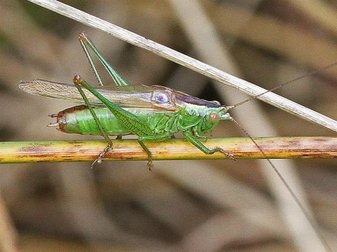 Male Long-winged Conehead, macropterous form copyright M. Foley
Male Long-winged Conehead, macropterous form copyright M. Foley
Both male and female Long-winged Coneheads were photgraphed on the green adjacent to Monk Wood Nature Reserve on 18th September. Amongst the photos were extra long-winged (macropterous) forms of both a male and female. This could mean that the species will be pushing further north and west.
Nymphs were also present at the site, which is not unusual with this species unlike the other bushcrickets. But are these youngsters the result of late hatching or are they a partial second brood?
Nymphs were also present at the site, which is not unusual with this species unlike the other bushcrickets. But are these youngsters the result of late hatching or are they a partial second brood?
Watch out for the bathroom bushcricket
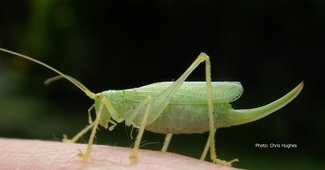 Female Oak Bushcricket, copyright C. Hughes
Female Oak Bushcricket, copyright C. Hughes
Oak Bushcrickets are known to enter buildings, drawn to light at night. This year is no exception and with resonable temperatures during the late summer they have been reported from several houses already. This species can persist into November so there's still time to get a few more records.
Short-winged Conehead, first for the year and a new site
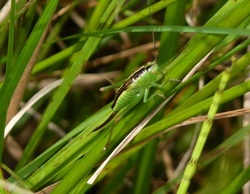 Short-winged Conehead at Fox Hollies Park. Copyright D. Jennings
Short-winged Conehead at Fox Hollies Park. Copyright D. Jennings
Short-winged Coneheads are still fairly uncommon in the area so it is always good to get records from new sites. Sub-adult coneheads have been found at Fox Hollies Park just inside VC37. This is the first record of the species this year and a new site. The fact that the cricket photographed was a nymph obviously means that they must have been there last year to breed, showing how easily over-looked this species is.
The habitat is also interesting; areas of rushes and horse-tail within dry grassland. So could the Short-winged Conehead be getting less fussy about habitat in the county and starting to spread??
The habitat is also interesting; areas of rushes and horse-tail within dry grassland. So could the Short-winged Conehead be getting less fussy about habitat in the county and starting to spread??
Dark Bushcrickets; first report
|
Lots of Dark Bushcricket nymphs were noted along the banks of the River Severn near Bewdley on 11th May. This is often the first species to be seen in spring as they are very distinctive and sit quite openly sunning themselves in sheltered locations. These were first or second instars and so are only a few days later than usual unlike many other insects such as dragonflies and butterflies that appear to be two or three weeks late emerging.
|
Common Groundhoppers out at last
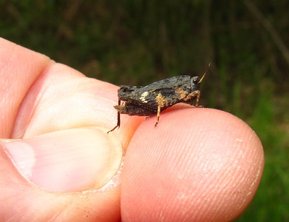 Common Groundhopper.
Common Groundhopper.
As with the Slender Groundhopper, the Common Groundhopper can be found as an adult in early spring. This year the first report received is from near Wyre Forest on 16th May; very late.
Bushcricket nymphs noted in Grafton Wood
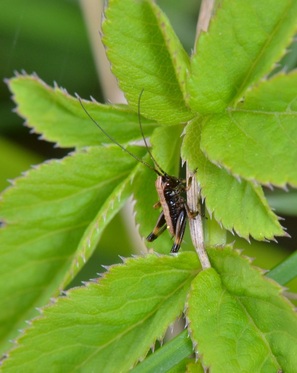
1st instar Dark Bushcricket - Grafton Wood 18.05.13
First instar Dark Bushcrickets in Grafton Wood18th May 2013.
About 2 weeks later than usual.
Not much bigger than an aphid at the moment but look in sheltered woodland rides around the county and you should find them now.
About 2 weeks later than usual.
Not much bigger than an aphid at the moment but look in sheltered woodland rides around the county and you should find them now.
|
First instar Speckled Bushcrickets at Grafton Wood 18th May. These tiny green crickets are covered in black spots (when viewed with a lens) even at this early age.
Check nettle patches and woodland rides. Even as adults this species is easily over-looked so take a close look in appropriate habitat and maybe try a sweep net. Could their similarity to aphids give them some protection from ants? |
First grasshoppers of 2013
|
Mottled Grasshoppers reported from Devil's Spittleful 31.05.13. This is a species of heathy grassland where the turf is broken exposing warm sandy soils.
Note the swollen antennae, incurved pronotum side keels and the oversized head; making this one of the easiest grasshoppers to identify when young. Common Groundhoppers were also noted. |
Oak Bushcricket nymph
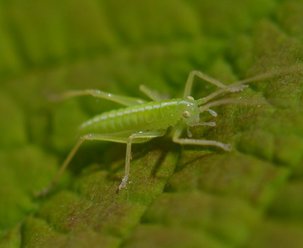 Oak Bushcricket second/third instar: Wyre Forest 15.06.13
Oak Bushcricket second/third instar: Wyre Forest 15.06.13
The Wyre Forest Study Group recorded the first Oak Bushcricket nymph of the year for Worcestershire on 15th June. This second or third instar was found in an area of heath under an oak following a heavy rain shower.
Common Groundhoppers were also present.
Common Groundhoppers were also present.
Lesne's Earwigs - first record of the year
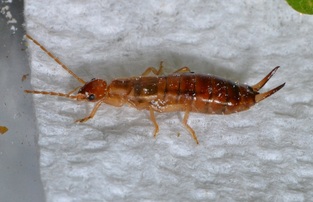 Lesne's Earwig (female) Evesham Country Park 21.06.13
Lesne's Earwig (female) Evesham Country Park 21.06.13
A total of seven adult Lesne's Earwigs were swept from low vegetation at Evesham Country Park along the river walk on 21st June. They were in vegetation close to Old-man's Beard (their preferred host during the late summer/autumn) with tussock grasses and Hogweed. Interestingly they were all females; is this usually the case at this time of year? There were many immature earwigs present but these were not identified to species although some have been taken to 'grow on' to check identification later.
There were also may Dark and Speckled Bushcricket nymphs present.
There were also may Dark and Speckled Bushcricket nymphs present.
Lesser Earwig in Urban Garden 26.06.13
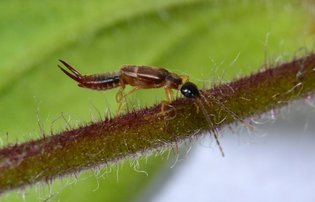 Lesser Earwig on Red Campion 26.06.13
Lesser Earwig on Red Campion 26.06.13
Lesser Earwigs are associated with compost heaps and manure heaps so it was a surprise to have one reported from Red Campion in a garden in Redditch.
This tiny earwig is almost certainly more common than records suggest so check around your garden compost bin. It closely resembles a small Staphilinid or Rove beetle, but on close inspection has typical earwig cerci (pincers).
This tiny earwig is almost certainly more common than records suggest so check around your garden compost bin. It closely resembles a small Staphilinid or Rove beetle, but on close inspection has typical earwig cerci (pincers).
Grasshoppers singing at last
|
|
Meadow Grasshoppers are being reported from a few places now including Upton Warren. This species appears to be losing ground so any records are useful.
The female (pictured left) usually has short wings which makes it quite easy to identify. The male is very similar to Lesser Marsh Grasshopper but usually brighter coloured with dark hind knees. |
Long-winged Coneheads make an appearence
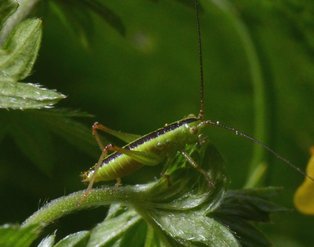 Long-winged Conehead early instar at Trench Wood 14.07.13
Long-winged Conehead early instar at Trench Wood 14.07.13
Several early instar Long-winged Coneheads were found in the main glade at Trench wood 14th July 2013. They were in an area with a variety of grasses, sedges and rushes as well as various flowering plants such as Tormentil and Betony.
It is still safe to say that any conehead nymphs found away from good wetland sites in the county are Long-winged.
There were also Speckled and Dark Bushcrickets, Meadow Grasshoppers and Common Groundhoppers present.
It is still safe to say that any conehead nymphs found away from good wetland sites in the county are Long-winged.
There were also Speckled and Dark Bushcrickets, Meadow Grasshoppers and Common Groundhoppers present.
Hoppers Galore
|
The few hot days have certainly brought things on with nearly all of our resident species now mature and singing.
The only exceptions seem to be the coneheads; lots around but still immature. Oddly there were no reports of immature Roesel's Bushcricket but all of a sudden they are singing in abundance. |
First of the year 2013
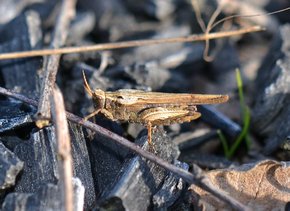
Slender Groundhopper - Trench Wood 07.05.13
Slender Groundhoppers in Tiddesley Wood (05.05.13) and Trench Wood (07.05.13). This species overwinters in various life stages so it is not unusual to see adults in early spring.
Mega-Leck of Dark Bush-crickets in Grafton Wood
|
In late summer 2012 one small bench in Grafton Wood Nature Reserve became the focus of attention as large numbers of Dark Bushcrickets gathered on and around it. All of the grasshoppers and bushcrickets sing to attract mates and warn off rivals (as birds do) and various items from cow-pats to pieces of discarded metal will do. On this occassion the tall vegetation behind the bench must have given just the right conditions for a mega-leck. I have never seen so many bushcrickets in one place so it will be interesting to see if this becomes a regular spectacle at the reserve.
|
